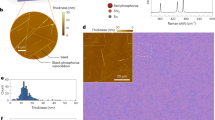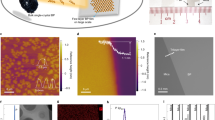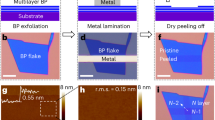Abstract
Two-dimensional crystals have emerged as a class of materials that may impact future electronic technologies. Experimentally identifying and characterizing new functional two-dimensional materials is challenging, but also potentially rewarding. Here, we fabricate field-effect transistors based on few-layer black phosphorus crystals with thickness down to a few nanometres. Reliable transistor performance is achieved at room temperature in samples thinner than 7.5 nm, with drain current modulation on the order of 105 and well-developed current saturation in the I–V characteristics. The charge-carrier mobility is found to be thickness-dependent, with the highest values up to ∼1,000 cm2 V−1 s−1 obtained for a thickness of ∼10 nm. Our results demonstrate the potential of black phosphorus thin crystals as a new two-dimensional material for applications in nanoelectronic devices.
This is a preview of subscription content, access via your institution
Access options
Subscribe to this journal
Receive 12 print issues and online access
$259.00 per year
only $21.58 per issue
Buy this article
- Purchase on Springer Link
- Instant access to full article PDF
Prices may be subject to local taxes which are calculated during checkout




Similar content being viewed by others
References
Delhaès, P. Graphite and Precursors (Gordon & Breach Science, 2001).
Brown, A. & Rundqvist, S. Refinement of the crystal structure of black phosphorus. Acta Crystallogr. 19, 684–685 (1965).
Slater, J. C., Koster, G. F. & Wood, J. H. Symmetry and free electron properties of the gallium energy bands. Phys. Rev. 126, 1307–1317 (1962).
Cartz, L., Srinivasa, S. R., Riedner, R. J., Jorgensen, J. D. & Worlton, T. G. Effect of pressure on bonding in black phosphorus. J. Chem. Phys. 71, 1718–1721 (1979).
Novoselov, K. S. et al. Electric field effect in atomically thin carbon films. Science 306, 666–669 (2004).
Berger, C. et al. Ultrathin epitaxial graphite: 2D electron gas properties and a route toward graphene-based nanoelectronics. J. Phys. Chem. B 108, 19912–19916 (2004).
Takao, Y. & Morita, A. Electronic structure of black phosphorus: tight binding approach. Physica B&C 105, 93–98 (1981).
Keyes, R. W. The electrical properties of black phosphorus. Phys. Rev. 92, 580–584 (1953).
Warschauer, D. Electrical and optical properties of crystalline black phosphorus. J. Appl. Phys. 34, 1853–1860 (1963).
Maruyama, Y., Suzuki, S., Kobayashi, K. & Tanuma, S. Synthesis and some properties of black phosphorus single crystals. Physica B&C 105, 99–102 (1981).
Akahama, Y., Endo, S. & Narita, S. Electrical properties of black phosphorus single crystals. J. Phys. Soc. Jpn 52, 2148–2155 (1983).
Rodin, A. S., Carvalho, A. & Neto, A. H. C. Strain-induced gap modification in black phosphorus. Preprint at http://arxiv.org/abs/1401.1801 (2014).
Asahina, H., Shindo, K. & Morita, A. Electronic structure of black phosphorus in self-consistent pseudopotential approach. J. Phys. Soc. Jpn 51, 1193–1199 (1982).
Jamieson, J. C. Crystal structures adopted by black phosphorus at high pressures. Science 139, 1291–1292 (1963).
Vanderborgh, C. A. & Schiferl, D. Raman studies of black phosphorus from 0.25 to 7.7 GPa at 15 K. Phys. Rev. B 40, 9595–9599 (1989).
Kawamura, H., Shirotani, I. & Tachikawa, K. Anomalous superconductivity in black phosphorus under high pressures. Solid State Commun. 49, 879–881 (1984).
Wittig, J. & Matthias, B. T. Superconducting phosphorus. Science 160, 994–995 (1968).
Radisavljevic, B., Radenovic, A., Brivio, J., Giacometti, V. & Kis, A. Single-layer MoS2 transistors. Nature Nanotech. 6, 147–150 (2011).
Radisavljevic, B. & Kis, A. Mobility engineering and a metal–insulator transition in monolayer MoS2 . Nature Mater. 12, 815–820 (2013).
Heyd, J., Scuseria, G. E. & Ernzerhof, M. Hybrid functionals based on a screened Coulomb potential. J. Chem. Phys. 118, 8207–8215 (2003).
Heyd, J., Peralta, J. E., Scuseria, G. E. & Martin, R. L. Energy band gaps and lattice parameters evaluated with the Heyd–Scuseria–Ernzerhof screened hybrid functional. J. Chem. Phys. 123, 174101 (2005).
Marsman, M., Paier, J., Stroppa, A. & Kresse, G. Hybrid functionals applied to extended systems. J. Phys. 20, 064201 (2008).
Schwierz, F. Graphene transistors. Nature Nanotech. 5, 487–496 (2010).
Liu, H., Neal, A. T. & Ye, P. D. Channel length scaling of MoS2 MOSFETs. ACS Nano 6, 8563–8569 (2012).
Das, S., Chen, H-Y., Penumatcha, A. V. & Appenzeller, J. High performance multilayer MoS2 transistors with scandium contacts. Nano Lett. 13, 100–105 (2013).
Knoch, J., Zhang, M., Appenzeller, J. & Mantl, S. Physics of ultrathin-body silicon-on-insulator Schottky-barrier field-effect transistors. Appl. Phys. A 87, 351–357 (2007).
Fontana, M. et al. Electron–hole transport and photovoltaic effect in gated MoS2 Schottky junctions. Sci. Rep. 3, 1634 (2013).
Schroder, D. K. Semiconductor Material and Device Characterization (Wiley, 2006).
Chen, J-H., Jang, C., Xiao, S., Ishigami, M. & Fuhrer, M. S. Intrinsic and extrinsic performance limits of graphene devices on SiO2 . Nature Nanotech. 3, 206–209 (2008).
Chen, F., Xia, J., Ferry, D. K. & Tao, N. Dielectric screening enhanced performance in graphene FET. Nano Lett. 9, 2571–2574 (2009).
Morozov, S. V. et al. Giant intrinsic carrier mobilities in graphene and its bilayer. Phys. Rev. Lett. 100, 016602 (2008).
Sze, S. M. & Ng, K. K. Physics of Semiconductor Devices (Wiley, 2006).
Kaasbjerg, K., Thygesen, K. S. & Jacobsen, K. W. Phonon-limited mobility in n-type single-layer MoS2 from first principles. Phys. Rev. B 85, 115317 (2012).
Petaccia, L. et al. BaDElPh: A normal-incidence monochromator beamline at Elettra. Nucl. Instrum. Methods 606, 780–784 (2009).
Blöchl, P. E. Projector augmented-wave method. Phys. Rev. B 50, 17953–17979 (1994).
Kresse, G. & Joubert, D. From ultrasoft pseudopotentials to the projector augmented-wave method. Phys. Rev. B 59, 1758–1775 (1999).
Kresse, G. & Furthmüller, J. Efficient iterative schemes for ab initio total-energy calculations using a plane-wave basis set. Phys. Rev. B 54, 11169–11186 (1996).
Krukau, A. V., Vydrov, O. A., Izmaylov, A. F. & Scuseria, G. E. Influence of the exchange screening parameter on the performance of screened hybrid functionals. J. Chem. Phys. 125, 224106 (2006).
Acknowledgements
The authors thank R. Tao, F. Wang, Y. Wu, L. Ma, M. Sui, G. Chen and F. Yang for discussions and F. Xiu, Y. Liu and C. Zhang for assistance with measurements in PPMS. Q.G. and D.F. acknowledge support from L. Petaccia, D. Lonza and the ICTP-Elettra Users Support Programme. Part of the sample fabrication was performed at Fudan Nano-fabrication Laboratory. L.L., Y.Y., Q.G., D.F. and Y.Z. acknowledge financial support from the National Basic Research Program of China (973 Program) under grant nos 2011CB921802, 2012CB921400 and 2013CB921902, and from the NSF of China under grant no. 11034001. G.J.Y. and X.H.C. acknowledge support from the ‘Strategic Priority Research Program’ of the Chinese Academy of Sciences under grant no. XDB04040100 and the National Basic Research Program of China (973 Program) under grant no. 2012CB922002. X.O. and H.W. are supported by the Pu Jiang Program of Shanghai under grant no. 12PJ1401000.
Author information
Authors and Affiliations
Contributions
X.H.C. and Y.Z. conceived the project. G.J.Y. and X.H.C. grew bulk black phosphorus crystal. L.L. fabricated black phosphorus thin-film devices and performed electric measurements, and L.L., Y.Y. and Y.Z. analysed the data. Q.G. and D.F. carried out ARPES measurements on bulk black phosphorus crystal. X.O. and H.W. performed ab initio band structure calculations. L.L. and Y.Z. wrote the paper and all authors commented on it.
Corresponding authors
Ethics declarations
Competing interests
The authors declare no competing financial interests.
Supplementary information
Supplementary information
Supplementary information (PDF 1401 kb)
Rights and permissions
About this article
Cite this article
Li, L., Yu, Y., Ye, G. et al. Black phosphorus field-effect transistors. Nature Nanotech 9, 372–377 (2014). https://doi.org/10.1038/nnano.2014.35
Received:
Accepted:
Published:
Issue Date:
DOI: https://doi.org/10.1038/nnano.2014.35
This article is cited by
-
Seeded growth of single-crystal black phosphorus nanoribbons
Nature Materials (2024)
-
Highly anisotropic spin transport in ultrathin black phosphorus
Nature Materials (2024)
-
Hard ferromagnetism in van der Waals Fe3GaTe2 nanoflake down to monolayer
npj 2D Materials and Applications (2024)
-
Realization of large-area ultraflat chiral blue phosphorene
Nature Communications (2024)
-
Manipulating hyperbolic transient plasmons in a layered semiconductor
Nature Communications (2024)



